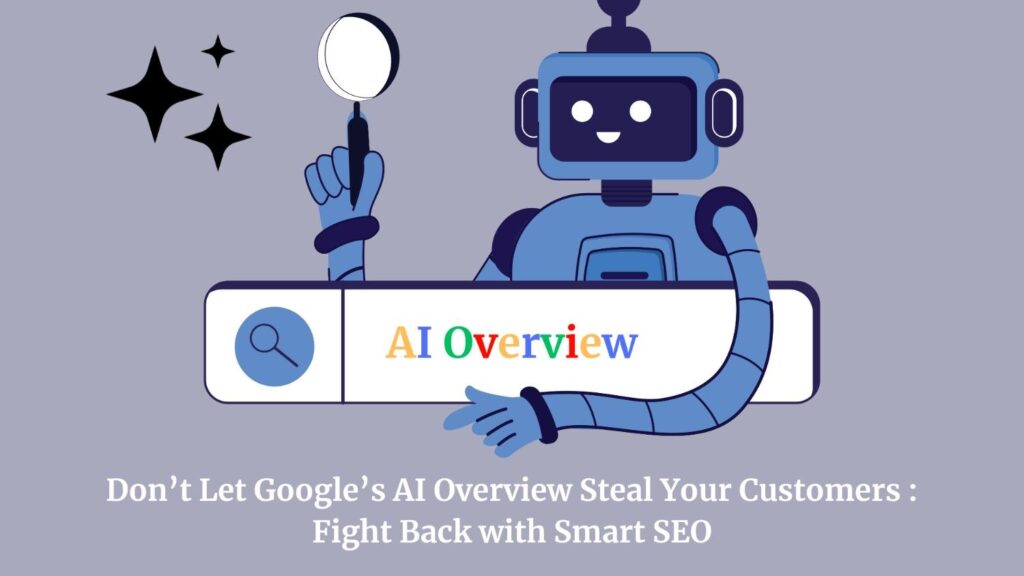Google’s new AI Overview is kind of a scene-stealer.
It shows up right at the top of search results, serves answers on a silver platter, and doesn’t even say thank you to the sites it borrowed from. While users love the convenience, businesses? Not so much. Because traffic that once clicked through to your page might now stop right there, never even seeing your carefully crafted content.
So, are we all doomed? Not quite. But if you’re not paying attention, you might be handing your leads straight to your competitors.
SEO isn’t dead. But the way we play the game? That’s shifting fast.
Wait, What Exactly Is an AI Overview?
In plain terms, Google’s AI Overview (previously part of SGE or Search Generative Experience) gives users summarized answers using AI-generated content at the top of the search page.
It reads like a super-smooth blog post mashed together from several sources, and yes, it barely leaves room for organic links to shine.
Suddenly, ranking #1 isn’t what it used to be. You might be on the page, but not in the spotlight.
Why You Should Care?
Let’s say you run an e-commerce store selling organic skincare. You’ve invested in content, got featured snippets, and even worked with a professional SEO company in India to polish your site.
Then, suddenly, Google’s AI Overview takes your long-form blog on “Benefits of Aloe Vera for Skin” and turns it into a three-line summary. Zero click. No engagement. Just… thanks for the content.
Frustrating? Yes. But this is where it gets interesting.
Good SEO Is No Longer Enough; It Has to Be Smarter
You can’t just rely on keyword density or tidy meta descriptions anymore. Smart SEO today means understanding how Google thinks, and more importantly, how its AI systems behave.
The AI Overview feature pulls from the content it deems authoritative, helpful, and context-rich. That’s your window of opportunity.
Here’s what that means for your SEO strategy:
- Focus on topical authority: Build clusters of content around themes, not just standalone posts. Google needs to see depth.
- Double down on experience: Add personal insights, original images, data, case studies, and anything AI can’t fake.
- Tidy up your structured data: Schema markup helps Google understand what your page is about, not just scan it.
And while we’re at it, maybe it’s time to partner with a leading SEO company in India, one that’s already testing content against AI Overview visibility.
Let’s Be Honest, AI Still Needs You
There’s a bit of irony here. While AI Overview is designed to simplify search, it still needs real content to do its job. It pulls from human-made websites, real-life examples, and credible voices.
So, the mission is clear: make sure your content is the one it chooses.
You don’t need to outrun every site; you just need to outrank the ones Google’s AI is reading from. And that’s doable.
Are you enjoying reading this blog post?
If you’re interested in having our team handle your marketing needs, please click here
Who Gets Hit the Hardest?
AI Overviews are especially ruthless in sectors like:
- Health & wellness (yep, skincare brands, that’s you)
- Finance (Google loves a quick tax tip)
- How-to and DIY content (think tutorials and listicles)
If your business relies on educational content for traffic, watch your analytics like a hawk. Traffic drops? CTR crashes? These could be early symptoms of “AI-snatching syndrome.”
Meanwhile, niche businesses and local services (hello, dentists in Surat and yoga instructors in Kochi) may feel less impact for now.
So... What's the Play?
It’s about future-proofing your SEO now, not six months later when traffic flatlines.
Here’s how to start:
- Audit your high-traffic blogs: Check if they appear in AI Overviews. Use tools like Semrush’s “SGE Impact Report” or Ahrefs updates.
- Update your content: Add FAQs, highlight firsthand experience, and include real data, don’t just rewrite for SEO, rewrite for AI.
- Build content clusters: Interlink your articles naturally around a core theme. Make your site a source, not a stopgap.
- Use author bios: Google likes content written by real people with credentials. Give it a reason to trust you.
- Don’t neglect technical SEO: Fast-loading pages, mobile readiness, and clean code still matter a lot.
The smarter your content, the more likely Google’s AI will see it as the source to summarize.
You’ve Got Two Choices: Adapt or Fade
The way users consume search results is shifting. The businesses that learn, adapt, and evolve will own visibility. The ones who resist change?
Well… you know what happens to dinosaurs.
And if you’re feeling a bit overwhelmed? That’s where we step in.
Magnarevo is more than an SEO agency India trusts; we’re your unfair advantage. We watch search trends like hawks, tweak strategies in real-time, and make sure your traffic doesn’t just survive… it thrives.
Final Thought: SEO Isn’t Dying, It’s Growing Up
Think of SEO today like parenting a teenager. It’s moodier, more unpredictable, and no longer listens to the old rules.
But give it the right structure, consistency, and attention, and it’ll reward you with long-term trust and growth.
So don’t wait for AI to take your traffic. Fight back with smarter content, tighter strategy, and the kind of SEO that earns Google’s respect.
Want to talk next steps? Let’s get your site back in the spotlight.
About Author
Raised in India, I earned a Masters in Marketing from Swinburne University. Initially in Sales, I pivoted to Digital Media in 2013. Now, as the driving force behind Magnarevo, I leverage my expertise to guide branding and marketing, leading our sales and marketing teams. Keen on collaborations, I guide businesses to elevate their digital presence. Reach out at karan@magnarevo.com. Specialities: Branding, marketing strategy, digital media, ad management, website development, and analytics.
